This is the mandate that Gaspésie Virtuelle, which specializes in digital archiving and 3D virtual tours, has given itself: to preserve the built and cultural heritage of Ukraine, put at risk by the war launched a year ago by Russians.
Maria’s business in Gaspésie put its platform online two weeks ago. There are already six emblematic places of Ukraine, mainly museums, churches and castles, including the National Museum of Science and Natural History, the Klitschko Museum, the Leopold Levitskyi Museum and the Zbarazh Castle.
Each week a new location will be added. Provided that the war allows it. For example, the film crew was supposed to go to Kherson next week (in the South), but the project was postponed due to the current fighting.
“Our goal is to virtually preserve the cultural sites and historical monuments of Ukraine, because we don’t know if they will be destroyed,” says the president of Gaspésie Virtuelle, Yann Ménard.
We constantly talk about the war, but we also want people to discover Ukrainian culture, and see the beauty of the places there.
Yann Ménard, President of Virtual Gaspésie
About twenty buildings have been chosen and are awaiting digitization.
Virtual Gaspésie, which works with several Quebec museums — it is she who created the 3D virtual tours of the Montreal Museum of Fine Arts (MMFA) during the pandemic —, has partnered with the Ukrainian company Right Way, which chooses the places to be scanned, takes the photos and provides the data to the Quebec company, which does the editing.
The narration is done only in English – for the moment – but a French version is in preparation.
“We worked with Right Way before the war,” says Yann Ménard. They had purchased a license of our scanning software to offer 3D and virtual reality services to real estate agencies across the country. But with the war, they ceased their activities. »
They had started working on the digitization project for the National Museum of Science and Natural History, we offered to help them and we thought: why not do the same for other buildings?
Yann Ménard, President of Virtual Gaspésie
And the project started. But no one is paid in Quebec to work on this project funded by private donations and soon sponsorships.
“Half of the donations we receive go to Right Way so that they can do the work of tracking down, photographing and scanning,” Yann Ménard tells us. The other half is donated to a religious aid organization, St. Martin Center, which helps those most in need, especially children. With the war, of course, it is not the needs that are lacking…

SCREENSHOT FROM DISCOVER UKRAINE PLATFORM
Inside the National Museum of Science and Natural History
The goal of Gaspésie Virtuelle and Right Way is to raise at least $10,000. In a few weeks, they would have already received half of this sum, which bodes well for the future.
Small team
You would think that several dozen people are working on this cultural preservation mandate, but no.
Barely four people at Gaspésie Virtuelle and three at Right Way. “These are small teams, but our software is quite efficient, once we have the digitized content, it’s done quite well, specifies Yann Ménard. We added a map to geolocate the places and we downloaded all the 3D on the web, that’s what took the longest. »
Since 2020, Virtual Gaspésie has sold more than 2,000 licenses of its scanning software.
A little less than a third of its clients are museums — the MMFA, but also the Musée de la civilization de Québec. Abroad, the Quebec company works with the Ministry of Antiquity in Egypt, among others. Virtual Gaspésie is also very present in the maritime sector — the Canadian Coast Guard, cruise ships, etc. — as well as with auction houses like Christie’s.
“We would like to continue this work in Ukraine after the war, and reproduce this experience in other countries, says Yann Ménard. The demand for “digital twins” is strong, so there are plenty of possibilities. »
